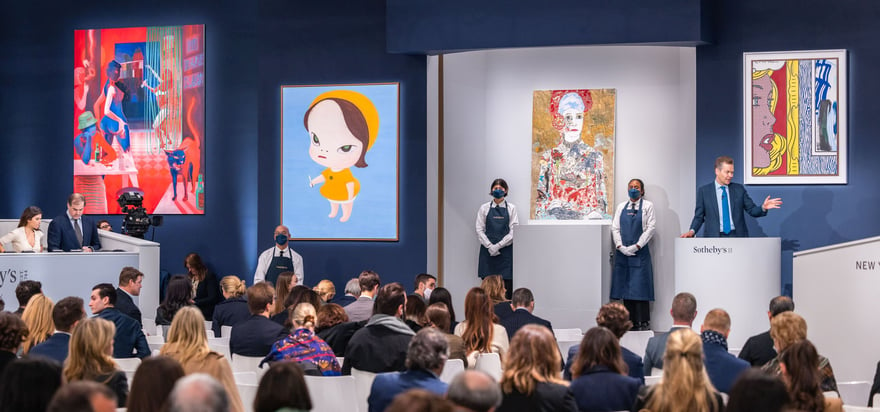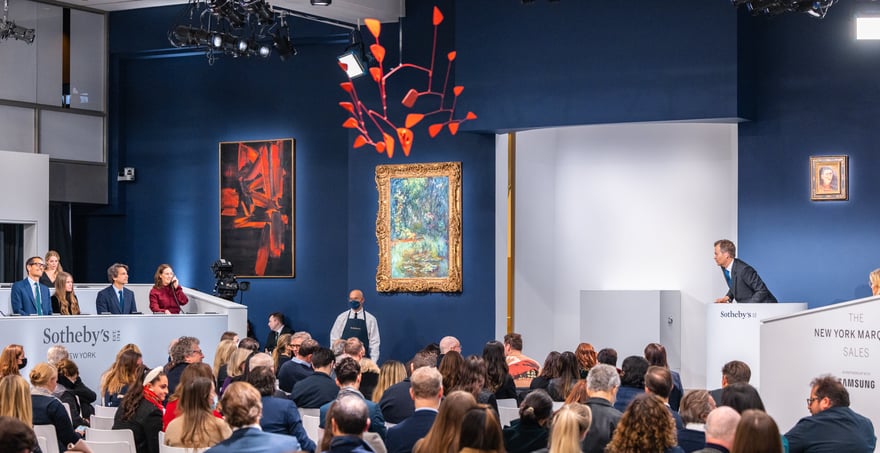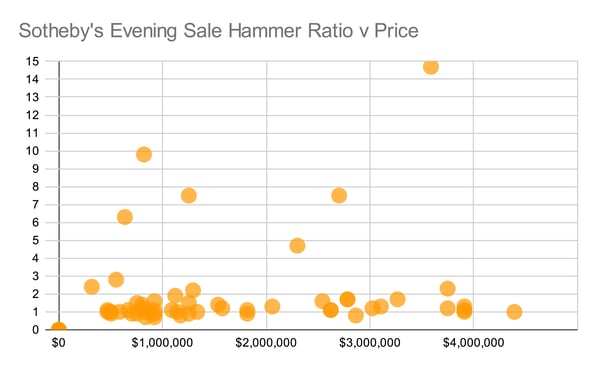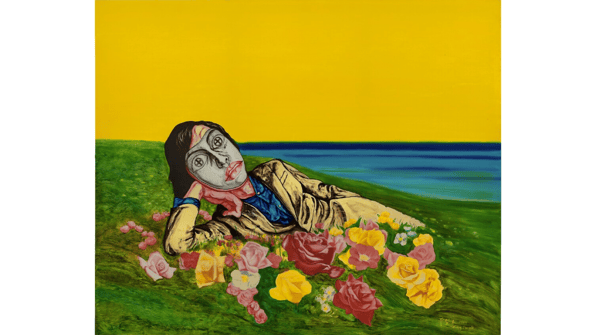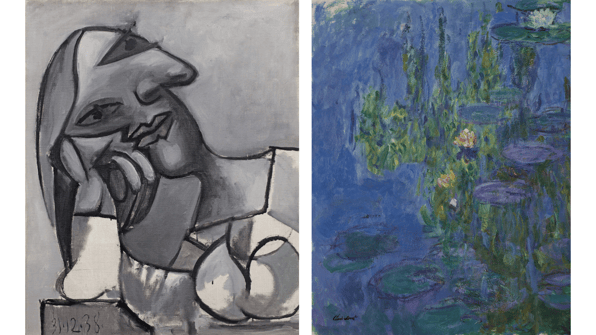Dual Sales within a Single Market: Sotheby's $191m Contemporary Sale
A crucial auction season ends with heavy competition for emerging artists and Douglas Cramer’s estate
Sotheby’s final night of sales capped off the astonishing November 2021 auction season bracketing a wild evening of record-setting sales and a legendary taste maker’s market-thrilling divestiture around the oddest rare book and manuscript single-lot auction ever staged.
It seems like months ago that Sotheby’s held the massive Macklowe sale; but it was only Monday. By Thursday, it had finished the week with a various owners sale of Contemporary art that included a number of significant lots from the estate of Douglas Cramer, the television producer who died earlier in the year. If one only looked at the results from Macklowe, Christie’s Cox collection and the Cramer sale, it would be tempting to conclude that we are in one phase of the market cycle that favors big name artists from big name collectors.
Thursday’s The Now sale at Sotheby's seemed to demonstrate the opposite. Record and near-record prices were set for artists like Lisa Brice, Toyin Ojih Odutola, Hernan Bas, Marií Berrîo, Christina Quarles, Lukas Duwenhögger, Jordan Casteel, Stanley Whitney, Matthew Wong and Flora Yukhnovich. This sale, taken in isolation, would suggest a the market is in a rollicking phase of discovery.
Douglas Cramer was a habitual buyer and seller of art. Auction houses were delighted to feature his works in sales. The first was in 1997 when Christie’s sold $2.9 million in sculptures. In 2001, Cramer sold $16m or so in art at Sotheby's. In 2012, he sold nine works at Christie’s netting $18 million. This week’s Cramer lots netted somewhere in the region of $50 million. Along the way Cramer sold notable works like a Richard Prince Nurse painting that set a record price for the artist in 2008.
One artist that Cramer bought and sold repeatedly was Roy Lichtenstein. Two Paintings was the top art work of the evening at $20.3 million. The sale price barely cracked the list of 20 most valuable Lichtenstein’s sold at auction. The dogged, global and sustained bidding took six full minutes to get to the hammer price up to the high end of the estimate range. Cramer also had a work, Small House, that sold well above the $600,000 low estimate to make $1.47 million all in. Two other Lichtenstein works not from Cramer’s collection were fought over in the sale, also exceeding the estimates. Mirror #1 from 1969 carried a $1.8 million low estimate but was bid to $4.6 million.
It turns out that Cramer had owned a different Mirror No. 1 from 1969, an oval mirror, that he sold in 2001 for $2.1 million. The Macklowes also own a Lichtenstein mirror painting which we'll presumably see in the Spring when the rest of the collection is sold.
Lichtenstein’s take on (the other star of the auction season) Vincent van Gogh’s Bedroom at Arles from 1992 also soared quadrupling the low estimate of $900,000 to make $4.255 million with fees.
Additional explosive results came from an Ed Ruscha gunpowder drawing from 1967. At $3.287 million with fees, Face It became the second most expensive Ruscha work on paper to be sold at auction.
In 2012, Cramer sold a Cecily Brown painting that made a quaint $782,500. This time around, two of his Cecily Browns were nothing less than a phenomenon. Spree sold for $6.58 million against a $3m low estimate; Bend Sinister, a surprise lot that carried an $800,000 low estimate, sold for nearly the same at $6.35 million. In the space of 15 minutes, the two works became the second and third highest auction prices for the artist. Cramer’s deep history with Brown and overall provenance surely had something to do with it. But not everything. A few minutes later, Untitled (Trapeze) was sacrificed in a strong market for $806,500 against a $1.5 million low estimate.
Outside of the Cramer collection, the sale had two notable works. The first didn’t seem very special. A larger number of Christopher Wool works were available on the market this season. The Macklowes collected Wool in depth. Others were selling Wool these last two weeks, too, even though the artist’s market has come down sharply since the days of his Guggenheim retrospective. Nevertheless, Gregoire Billault was confident that his Wool “Spray” work was not only of the highest quality—and the fine nuances of what makes one Wool greater than another can lost on even sophisticated art lovers—but that there would be bidders for it. (There had been few bidders throughout the week for any but the works offered below $1 million.)
Billault was right. Although he had taken an irrevocable bid as insurance, six bidders helped the work climb from the $6 million low estimate to the nearly $13.2 million selling price with premium. That falls just outside of the top ten Wool prices. But it does beat by a couple of million bucks the HA-AH word painting sold last week. Laurent Asscher, whose Ama Collection already owns a multi-color word painting by Wool, fingered himself as the buyer on Instagram. The consignor was likely to have been a heavy player of the third-party guarantee game.
Philip Guston’s Ominous Land saw an opening bid at the $6 million low estimate. Alex Branczik, soon to be in Hong Kong as Chairman of Asia for Sotheby’s, stopped by New York to bid on and buy the Guston for $8 million hammer, $9.45 million with fees. That is Guston’s fifth highest price at auction. The top five lots are now late, figurative works. This firmly shifts the narrative that once attached to the painter; namely, that he was an Abstract Expressionist master who lost his way late in life with a dramatic change in style.
Turning our attention to the now of The Now sale, Sotheby’s had a rousing success. The house was able to highlight a number of artists and accelerate their market growth. The first lot set the tone but also established a bar that few other works in the sale could meet. Works on paper by Lisa Brice had been making progress through the day sales but nothing prepared anyone for the $3.1 million paid at the beginning of The Now sale for the large 2017 painting No Bare Back, after Embah. The South African’s market is tightly controlled by her dealers and she received a lot of attention two months ago in a group show at London’s Heyward gallery. That explains her work appearing in the coveted first slot in the auction. It might have explained a high six-figure sale too. Whatever else happened remains a bit of mystery.
María Berrío’s Flor from 2013 had nine bidders push the work from $80,000 to $927,500. It was her first public sale, and what a sale it was. The Colombian-born, Brooklyn-based artist is represented by Victoria Miró. Her stable mate, Flora Yukhnovich, set a confirmation price a few lots later with It’s Better Down Where It’s Wetter which sold for $1.835 million against a $150,000 low estimate. That is her second highest price at auction after the blow-out sale in October of I’ll Have What She’s Having for $3.155 million but above the untitled work that makes $1.27 million that same month.
Toyin Ojih Odutola’s rare self portrait, Through Line, was sold for four times the $500,000 low estimate to make a new record for the artist at $2.198 million. Seven bidders drove the work to 2.5 times her previous high price for a paintign sold in the Spring. Josh Baer identified the buyer as investor Glenn Fuhrman.
Established artist Nicole Eisenman has had a run of sales recently. Her top price was set in the Winter at $1.19 million. In the Spring, there was a strong but not-confirming price at $334,675. The next month Whatever Guy from 2009 made an even stronger price at $840,700. At Sotheby’s, Groundsweller from 2014 closed the gap between the two to sell for $927,500.
The rush of works from deceased artist Matthew Wong has slowed to a handful this season. Wong’s most valuable works tent to be vibrantly multi-colored. So it was surprising to see eight bidders work Night Crossing, a blue-and-white work from 2018, to $4.86 million, a hair under the previous record at $4.87 million.
Half a dozen paintings by Hernan Bas have been sold in 2021 prior to the New York sales. Their prices ranged from $26,465 to $352,800, which was the high auction price for the artist. Night Flight was estimated at $150,000 but saw healthy bidding to $746,000 with fees, a new record for his work.
Two early works by Stanley Whitney came to market this season. The first made a $1.2 million last week. Even though that was a new record by a substantial margin, some observers in the audience felt the auctioneer left money on the table. To test that proposition, Sotheby’s had a stronger, earlier work estimated at a very appealing $150,000. Even with an IB attached, the bidding powered to a $2.3 million selling price which almost doubled the previous week’s record. QED.
Jordan Casteel’s impressive Crockett Brothers double portrait set a record for her market at $806,500. Laura Owens’s untitled work from 2016 was listed with an $800,000 low estimate. It made $1.59 million which is a strong confirmation price for the artist, her second highest price ever. Christina Quarles had set a record last year with Tuckt. This year she added $30,000 to the top price when Common Ground sold for $685,500. Lukas Duwenhögger is rarely traded. The way his bidding worked out, one might have expected to see the works stacked in the first few lots ramping up momentum. An esoteric painter, Duwenhögger’s work has a literary quality that can make it seem effete. The 1998 painting was estimated at $80,000. Bidding was robust; and the final price was $649,200.
The rest of the sale was bulked out with a George Condo, Lion Man, from 2012 priced at $2 million. It sold for $3.4 million which is Condo’s 12th highest price at auction and one of the highest values for a single-figure work.
